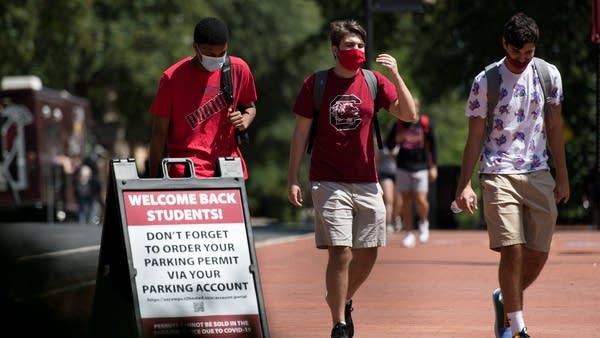How some colleges are trying to hold off another pandemic shutdown this fall
Testing, tracing, quarantine, masks, social distancing and student compliance are prerequisites for controlling COVID-19 on campus.

Millions of students are in college, but not at college, this fall. Their schools opted to open 100% remotely, with few or no students on campus, and all classes conducted online, to minimize the risk of COVID-19 spread.
But millions more students have started the fall semester living and learning on campus — even as the COVID-19 pandemic continues to rage. Their schools have either opened primarily in-person, or with a hybrid model (a mix of online and in-person instruction and student activities).
The results have been mixed so far. Colleges — large and small, public and private — have already experienced significant COVID-19 outbreaks among students and staff. The outbreaks have a range of causes, from poor adherence among students to public health protocols like mask-wearing and social distancing, to close-proximity activities like student athletics and dorm living, to mass-spreading events like bar crawls and frat parties.
Schools suffering these outbreaks — from UNC to Notre Dame to the University of Wisconsin to Florida State — have responded with large student quarantines, as well as student suspensions and expulsions. In some cases, in-person instruction and on-campus activities have been halted temporarily or indefinitely.
The financial incentive
But, many schools are operating with some or all students on campus, without so far experiencing serious COVID-19 outbreaks. And administrators have a huge financial incentive to bring and keep their students on campus if they can, according to Emily Wadhwani, who covers higher education at Fitch Ratings.
Wadhwani said this is especially true of private colleges and universities: “About 80% of their revenue comes from tuition and student fees — dorms, dining, parking, those sorts of things. Anyone who’s reliant on tuition and student fees is at elevated risk.” The exception, she said, is highly selective top-tier schools, such as Harvard and Stanford, with massive endowments to fall back on as revenues and enrollment fall in the pandemic.
“We do expect to see more closures as the fall season transitions into flu season,” said Wadhwani. “We hope to see a more orderly approach than we saw in the spring, where students were rather unceremoniously kicked off campus and told to stay home.”
Disorderly data
So far, higher education’s approach to the pandemic has been anything but orderly.
“It is a bit of the Wild West out there,” said Robert Franek, editor-in-chief at The Princeton Review. “There is no universal protocol about testing. Schools that are opening up — well-intentioned as that is — and then having to dramatically close or change policy is a huge financial burden on the school and crushing for students.”
Several nationwide dashboards are tracking schools’ policies and progress in the pandemic, including The New York Times, Davidson College and The Chronicle of Higher Education. But the data isn’t uniform or comprehensive, said University of Minnesota epidemiologist Kumi Smith.
“One thing that we’re learning is that we don’t have a great system in place to look on the whole at how universities and schools are doing at controlling COVID,” Smith said.
Smith said widespread compliance with mask-wearing and social distancing guidelines can clearly minimize COVID-19 spread. But on college campuses, she said, “some of those guidelines are just impossible to enforce or not practical.”
“Students are wearing masks all the time on campus — at least all the time that I’m around.”
Michael Roth, president of Wesleyan University
Smith pointed out that classes, dorms, dining halls, athletics, dance and theatre — the entire college experience — is by nature communal. She argues that expecting students not to hang out, go to parties and get close to each other is unrealistic.
“It does seem cruel to shut down schools or force kids to keep learning at home,” she said. “But how much can we plead with individuals to please behave in a way that’s really unnatural, and that goes against everything we’ve signaled about what college should be like. It’s a tall order.”
What it’s like to be on campus
One school trying to make it work is 190-year-old Wesleyan University, with approximately 2,500 students (mostly undergraduates) on a bucolic campus overlooking the Connecticut River in Middletown, Connecticut.
At the start of the semester, sophomore government major Kat Grealish flew back to Wesleyan from her home in Portland, Oregon. Despite the risk of getting COVID-19, or being sent home again like she was last spring, she said: “Just going to a classroom and sitting down and having the professor actually be there in person is so nice.”
Grealish said the college’s rules are clear for students: wear a mask in most settings, maintain social distance, don’t bring outside visitors onto campus, don’t gather in large groups. The school even offered an instructional video during fall orientation that included tips for dating without touching, she said: “Solutions ranged from listening to a podcast and drinking tea and then talking about it, to — and I’m quoting — ‘good old-fashioned phone sex.'”
Graelish has been observing student behavior as a reporter for the campus newspaper. “People are generally being pretty good,” she said. “But that being said, I have definitely heard rumblings of people having parties and stuff like that.”
Wesleyan President Michael Roth generally concurs. “Students are wearing masks all the time on campus,” he said, “at least all the time that I’m around.”
Roth said the school has had about 10 positive COVID-19 tests since late August (see Wesleyan’s COVID-19 dashboard here). And testing is rigorous — twice-a-week for all students and employees. He estimates the cost to the school at $5 million to $7 million.
“It’s expensive, but you have to test systematically,” he said. “And you have to have the capacity for isolating students in a way that isn’t punitive, so they’ll do it, and so you can break the chain of transmission. Otherwise you’re just depending on luck.”
Grealish thinks success depends mostly on the behavior of her peers. “I think there’s a big sense that either Wesleyan will get this right and we’ll stay here, or it’s just completely going to fall apart right away.”
There’s still a long way to go in the fall semester.













